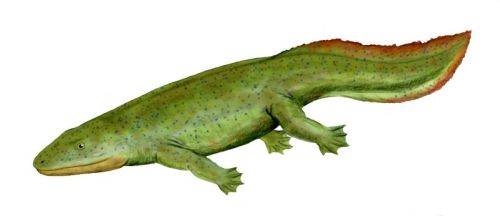
| Palaeos: |  |
Tetrapoda |
| The Vertebrates | Hynerpeton |
| Page Back | Unit Home | Unit Dendrogram | Unit References | Taxon Index | Page Next |
| Unit Back | Vertebrates Home | Vertebrate Dendrograms | Vertebrate References | Glossary | Unit Next |
|
Abbreviated Dendrogram
SARCOPTERYGII | TETRAPODA |--Acanthostega `--+--Ichthyostega `--+--Hynerpeton `--+--Tulerpeton `--+--Whatcheeriidae `--+--Crassigyrinus `--+--Colosteidae | `--Greererpeton `--+--Spathicephalus `--+--Baphetidae |--Eucritta `--Tetrapoda* |--TEMNOSPONDYLI `--+--LEPOSPONDYLI `--REPTILIOMORPHA |
Contents
Overview |
 Hynerpeton bassetti, life reconstruction, by Nobu Tamura Wikipedia, GNU Free Documentation/Creative Commons Attribution |
Editor's note: due to lack of time and the need to fuill out missing pages, this page has been copied verbatum (apart from the last sentence, which I added) from Wikipedia. Soem generic material has been excluded MAK111112
Hynerpeton was a basal carnivorous tetrapod that lived in the lakes and estuaries of the Late Devonian period around 360 million years ago. Like many primitive tetrapods, it is sometimes referred to as an "amphibian" . The Late Devonian saw the evolution of plants into trees and growing into vast forests pumping oxygen into the air, possibly giving Hynerpeton an edge because it evolved complex lungs to exploit it. Its lungs probably consisted of sacs like modern terrestrial vertebrates. In 1993, the paleontologists Ted Daeschler and Neil Shubin found the first Hynerpeton fossil, a shoulder bone, near Hyner, Pennsylvania. They were surveying the Devonian rocks of Pennsylvania in search of fossil evidence for the origin of animal limbs. The animal had a very robust shoulder, which indicated that it had powerful appendages. Only a few bones have been found from Hynerpeton, in Red Hill, Pennsylvania, U.S.A.. The known fossils include two shoulder girdles, two lower jaws, a jugal bone and some gastralia.
The structure of the shoulder girdle indicates this animal may have been one of the earlier, more primitive tetrapods to evolve during the Devonian. Information on the relationship of the known fossils of Hynerpeton to other Devonian tetrapods can be found in Gaining Ground The Origin and Evolution of Tetrapods by Jennifer A. Clack.
It is thought that that these early amphibians are descended from lobe-finned fish, such as Hyneria, whose stout fins evolved into legs and their swim bladder into lungs. It is still not known whether Hynerpeton is the direct ancestor to all later backboned land animals (including humans), but the fact that it had eight fingers, not five, suggests that it is simply our evolutionary cousin. However, that may not be relevant, as polydactly was standard among all early tetrapods
References:
Shubin, Neil (2009). Your Inner Fish: A Journey Into the 3.5-Billion-Year History of the Human Body. New York: Vintage. p. 13. ISBN 9780307277459.
Haines, Tim, and Paul Chambers. The Complete Guide to Prehistoric Life. Pg. 30-31. Canada: Firefly Books Ltd., 2006.
Hynerpeton: bassetti Daeschler et al., 1994
Range: Fammenian (Latest Devonian) of Pennsylvania
Phylogeny: Tetrapoda : Acanthostega + (Ichthyostega + (Tulerpeton + (Ossinodus + (Whatcheeriidae + (Crassigyrinus ::: Tetrapoda*)))) + *.))
Links: Devonian times
| Page Back | Unit Home | Page Top | Page Next |
Text content Dnswitzer101104; page MAK111112
